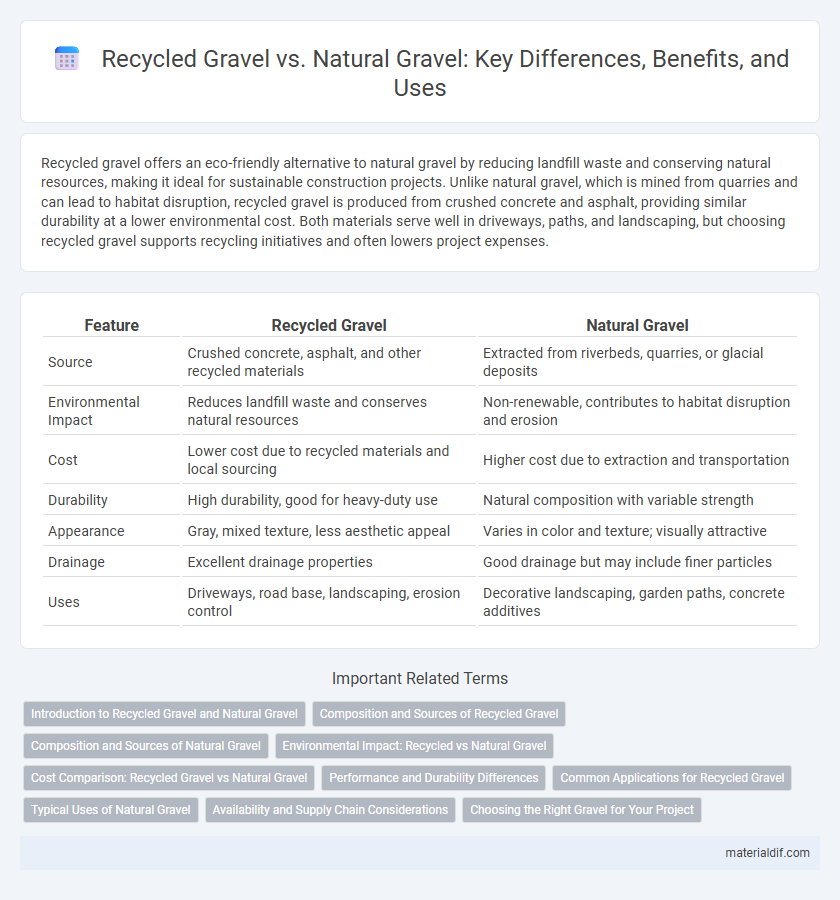Recycled gravel offers an eco-friendly alternative to natural gravel by reducing landfill waste and conserving natural resources, making it ideal for sustainable construction projects. Unlike natural gravel, which is mined from quarries and can lead to habitat disruption, recycled gravel is produced from crushed concrete and asphalt, providing similar durability at a lower environmental cost. Both materials serve well in driveways, paths, and landscaping, but choosing recycled gravel supports recycling initiatives and often lowers project expenses.
Table of Comparison
| Feature | Recycled Gravel | Natural Gravel |
|---|---|---|
| Source | Crushed concrete, asphalt, and other recycled materials | Extracted from riverbeds, quarries, or glacial deposits |
| Environmental Impact | Reduces landfill waste and conserves natural resources | Non-renewable, contributes to habitat disruption and erosion |
| Cost | Lower cost due to recycled materials and local sourcing | Higher cost due to extraction and transportation |
| Durability | High durability, good for heavy-duty use | Natural composition with variable strength |
| Appearance | Gray, mixed texture, less aesthetic appeal | Varies in color and texture; visually attractive |
| Drainage | Excellent drainage properties | Good drainage but may include finer particles |
| Uses | Driveways, road base, landscaping, erosion control | Decorative landscaping, garden paths, concrete additives |
Introduction to Recycled Gravel and Natural Gravel
Recycled gravel consists of crushed concrete, asphalt, and other construction debris repurposed for use in landscaping and construction projects, offering an eco-friendly alternative to natural materials. Natural gravel is formed through the erosion and weathering of rocks over thousands of years, typically sourced from riverbeds or quarries, providing a consistent and durable aggregate. Both types serve essential roles in sustainable construction, with recycled gravel reducing landfill waste and natural gravel offering superior structural integrity.
Composition and Sources of Recycled Gravel
Recycled gravel primarily consists of crushed concrete, asphalt, and masonry debris sourced from construction and demolition waste, offering an eco-friendly alternative to natural gravel extracted from riverbeds or quarries. Compositionally, recycled gravel contains various mineral compounds and aggregates bonded by cement or asphalt residues, which can affect its density and drainage properties compared to the more uniform mineralogy of natural gravel. Utilizing recycled gravel redirects waste from landfills and reduces environmental impact by minimizing the need for virgin aggregate extraction.
Composition and Sources of Natural Gravel
Natural gravel is composed primarily of rounded rock fragments, sand, and mineral particles, originating from the weathering and erosion of rocks in riverbeds, glacial deposits, and sedimentary basins. Its sources include riverbanks, glacial moraines, and beach deposits, where natural processes sort and shape the gravel over time. Unlike recycled gravel, natural gravel maintains its original mineral composition and physical characteristics, making it highly valued for construction and landscaping projects.
Environmental Impact: Recycled vs Natural Gravel
Recycled gravel significantly reduces environmental impact by minimizing the need for quarrying and preserving natural landscapes, while lowering landfill waste through material reuse. Natural gravel extraction results in habitat disruption, increased carbon emissions, and soil erosion due to mining processes. Utilizing recycled gravel promotes sustainable resource management and reduces the carbon footprint associated with transportation and raw material processing.
Cost Comparison: Recycled Gravel vs Natural Gravel
Recycled gravel typically costs 30-50% less than natural gravel due to lower extraction and transportation expenses. Natural gravel prices fluctuate based on quarry location, availability, and quality, often leading to higher overall costs. Choosing recycled gravel offers an affordable, sustainable alternative without compromising on durability for most construction and landscaping projects.
Performance and Durability Differences
Recycled gravel often exhibits comparable performance to natural gravel in terms of load-bearing capacity and compaction, but may contain varying levels of impurities affecting long-term durability. Natural gravel typically offers higher consistency, superior resistance to weathering, and reduced risk of fragmentation under heavy use. Selecting between recycled and natural gravel depends on project demands, with natural gravel favored for longevity and structural integrity while recycled gravel provides an eco-friendly, cost-effective alternative.
Common Applications for Recycled Gravel
Recycled gravel is commonly used in landscaping, garden paths, and driveways due to its cost-effectiveness and environmental benefits. It provides excellent drainage and compaction, making it ideal for base layers in construction projects and roadways. Compared to natural gravel, recycled gravel is favored for sustainable building practices and erosion control.
Typical Uses of Natural Gravel
Natural gravel is commonly used in landscaping, driveway construction, and concrete production due to its durability and aesthetic appeal. It is preferred for drainage systems and erosion control because of its consistent size and natural composition. The mineral content and texture of natural gravel make it ideal for decorative garden beds and pathways, enhancing outdoor spaces with natural color variations.
Availability and Supply Chain Considerations
Recycled gravel offers a more sustainable and abundant alternative to natural gravel, particularly in urban areas where construction and demolition waste provide a steady supply. Natural gravel extraction faces increasing regulations and environmental restrictions that limit availability and complicate the supply chain. Using recycled gravel reduces transportation costs and environmental impacts, enhancing logistics efficiency compared to quarry-dependent natural gravel sources.
Choosing the Right Gravel for Your Project
Recycled gravel offers an eco-friendly alternative to natural gravel, made from crushed concrete and other reclaimed materials, providing durability and cost-effectiveness for construction projects. Natural gravel, sourced directly from riverbeds or quarries, typically features smoother textures and consistent particle sizes, ideal for landscaping and drainage applications. Selecting the right gravel depends on project requirements such as load-bearing capacity, aesthetic preference, and environmental considerations.
Recycled Gravel vs Natural Gravel Infographic

 materialdif.com
materialdif.com